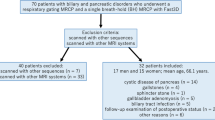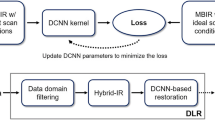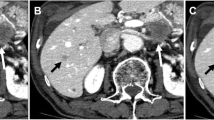Abstract
Purpose
Deep learning reconstruction (DLR) introduces deep convolutional neural networks into the reconstruction flow. We examined the clinical applicability of drip-infusion cholangiography (DIC) acquired on an ultra-high-resolution CT (U-HRCT) scanner reconstructed with DLR in comparison to hybrid and model-based iterative reconstruction (hybrid-IR, MBIR).
Methods
This retrospective, single-institution study included 30 patients seen between January 2018 and November 2019. A radiologist recorded the standard deviation of attenuation in the paraspinal muscle as the image noise and calculated the contrast-to-noise ratio (CNR) in the common bile duct. The overall visual image quality of the bile duct on thick-slab maximum intensity projections was assessed by two other radiologists and graded on a 5-point confidence scale ranging from 1 (not delineated) to 5 (clearly delineated). The difference among hybrid-IR, MBIR, and DLR images was compared.
Results
The image noise was significantly lower on DLR than hybrid-IR and MBIR images and the CNR and the overall visual image quality of the bile duct were significantly higher on DLR than on hybrid-IR and MBIR images (all: p < 0.001).
Conclusion
DLR resulted in significant quantitative and qualitative improvement of DIC acquired with U-HRCT.





Similar content being viewed by others
References
Kitami M, Takase K, Murakami G, Ko S, Tsuboi M, Saito H, Higano S, Nakajima Y, Takahashi S (2006) Types and frequencies of biliary tract variations associated with a major portal venous anomaly: analysis with multi-detector row CT cholangiography. Radiology 238 (1):156-166. https://doi.org/10.1148/radiol.2381041783
Hyodo T, Kumano S, Kushihata F, Okada M, Hirata M, Tsuda T, Takada Y, Mochizuki T, Murakami T (2012) CT and MR cholangiography: advantages and pitfalls in perioperative evaluation of biliary tree. Br J Radiol 85 (1015):887-896. https://doi.org/10.1259/bjr/21209407
Edo H, Sekiguchi R, Edo N, Kajiyama A, Nagamoto M, Gomi T (2019) Evaluation of biliary anatomy in the caudate lobe using drip infusion cholangiography-computed tomography. Abdom Radiol (NY) 44 (3):886-893. https://doi.org/10.1007/s00261-018-1825-4
Yeh BM, Breiman RS, Taouli B, Qayyum A, Roberts JP, Coakley FV (2004) Biliary tract depiction in living potential liver donors: comparison of conventional MR, mangafodipir trisodium-enhanced excretory MR, and multi-detector row CT cholangiography--initial experience. Radiology 230 (3):645-651. https://doi.org/10.1148/radiol.2303021775
Chen JS, Yeh BM, Wang ZJ, Roberts JP, Breiman RS, Qayyum A, Coakley FV (2005) Concordance of second-order portal venous and biliary tract anatomies on MDCT angiography and MDCT cholangiography. AJR Am J Roentgenol 184 (1):70-74. https://doi.org/10.2214/ajr.184.1.01840070
Kakinuma R, Moriyama N, Muramatsu Y, Gomi S, Suzuki M, Nagasawa H, Kusumoto M, Aso T, Tsuchida T, Tsuta K, Maeshima AM, Tochigi N, Watanabe S, Sugihara N, Tsukagoshi S, Saito Y, Kazama M, Ashizawa K, Awai K, Honda O, Ishikawa H, Koizumi N, Komoto D, Moriya H, Oda S, Oshiro Y, Yanagawa M, Tomiyama N, Asamura H (2015) Ultra-High-Resolution Computed Tomography of the Lung: Image Quality of a Prototype Scanner. PLoS One 10 (9):e0137165. https://doi.org/10.1371/journal.pone.0137165
Motoyama S, Ito H, Sarai M, Nagahara Y, Miyajima K, Matsumoto R, Doi Y, Kataoka Y, Takahashi H, Ozaki Y, Toyama H, Katada K (2018) Ultra-High-Resolution Computed Tomography Angiography for Assessment of Coronary Artery Stenosis. Circulation journal: official journal of the Japanese Circulation Society. https://doi.org/10.1253/circj.cj-17-1281
Tanaka R, Yoshioka K, Takagi H, Schuijf JD, Arakita K (2018) Novel developments in non-invasive imaging of peripheral arterial disease with CT: experience with state-of-the-art, ultra-high-resolution CT and subtraction imaging. Clin Radiol. https://doi.org/10.1016/j.crad.2018.03.002
Yanagawa M, Hata A, Honda O, Kikuchi N, Miyata T, Uranishi A, Tsukagoshi S, Tomiyama N (2018) Subjective and objective comparisons of image quality between ultra-high-resolution CT and conventional area detector CT in phantoms and cadaveric human lungs. Eur Radiol 28 (12):5060-5068. https://doi.org/10.1007/s00330-018-5491-2
Nakayama Y, Awai K, Funama Y, Hatemura M, Imuta M, Nakaura T, Ryu D, Morishita S, Sultana S, Sato N, Yamashita Y (2005) Abdominal CT with low tube voltage: preliminary observations about radiation dose, contrast enhancement, image quality, and noise. Radiology 237 (3):945-951. https://doi.org/10.1148/radiol.2373041655
Akagi M, Nakamura Y, Higaki T, Narita K, Honda Y, Zhou J, Yu Z, Akino N, Awai K (2019) Deep learning reconstruction improves image quality of abdominal ultra-high-resolution CT. Eur Radiol 29 (11):6163-6171. https://doi.org/10.1007/s00330-019-06170-3
Tatsugami F, Higaki T, Nakamura Y, Yu Z, Zhou J, Lu Y, Fujioka C, Kitagawa T, Kihara Y, Iida M, Awai K (2019) Deep learning-based image restoration algorithm for coronary CT angiography. Eur Radiol 29 (10):5322-5329. https://doi.org/10.1007/s00330-019-06183-y
Nakamura Y, Higaki T, Tatsugami F, Zhou J, Yu Z, Akino N, Ito Y, Iida M, Awai K (2019) Deep Learning-based CT Image Reconstruction: Initial Evaluation Targetting Hypovascular Hepatic Metastases. Radiology: Artificial Intelligence. https://doi.org/10.1148/radiol.2016151061
Cohen J (1988) Statistical power analysis for the behavior sciences. second edition edn. Lawrence Erlbaum, Hillsdale, NJ
Stockberger SM, Wass JL, Sherman S, Lehman GA, Kopecky KK (1994) Intravenous cholangiography with helical CT: comparison with endoscopic retrograde cholangiography. Radiology 192 (3):675-680. https://doi.org/10.1148/radiology.192.3.8058932
Brady SL, Kaufman RA (2012) Investigation of American Association of Physicists in Medicine Report 204 size-specific dose estimates for pediatric CT implementation. Radiology 265 (3):832-840. https://doi.org/10.1148/radiol.12120131
Christner JA, Braun NN, Jacobsen MC, Carter RE, Kofler JM, McCollough CH (2012) Size-specific dose estimates for adult patients at CT of the torso. Radiology 265 (3):841-847. https://doi.org/10.1148/radiol.12112365
American Association of Physicists in Medicine (2011) Size-Specific Dose Estimates (SSDE) in Pediatric and Adult Body CT Examinations (Task Group 204). American Association of Physicists in Medicine, College Park, MD. https://www.aapm.org/pubs/reports/RPT_204.pdf
Yoon JH, Lee SM, Kang HJ, Weiland E, Raithel E, Son Y, Kiefer B, Lee JM (2017) Clinical Feasibility of 3-Dimensional Magnetic Resonance Cholangiopancreatography Using Compressed Sensing: Comparison of Image Quality and Diagnostic Performance. Invest Radiol 52 (10):612-619. https://doi.org/10.1097/RLI.0000000000000380
Hur BY, Lee JM, Joo I, Yu MH, Yoon JH, Han JK, Choi BI (2014) Liver computed tomography with low tube voltage and model-based iterative reconstruction algorithm for hepatic vessel evaluation in living liver donor candidates. J Comput Assist Tomogr 38 (3):367-375. https://doi.org/10.1097/rct.0b013e3182ab6cc0
Phelps AS, Naeger DM, Courtier JL, Lambert JW, Marcovici PA, Villanueva-Meyer JE, MacKenzie JD (2015) Pairwise comparison versus Likert scale for biomedical image assessment. AJR Am J Roentgenol 204 (1):8-14. https://doi.org/10.2214/ajr.14.13022
Likert R (1932) A technique for the measurement of attitudes. Arch Psychol 140:55
Schroeder T, Radtke A, Kuehl H, Debatin JF, Malago M, Ruehm SG (2006) Evaluation of living liver donors with an all-inclusive 3D multi-detector row CT protocol. Radiology 238 (3):900-910. https://doi.org/10.1148/radiol.2382050133
Svanholm H, Starklint H, Gundersen HJ, Fabricius J, Barlebo H, Olsen S (1989) Reproducibility of histomorphologic diagnoses with special reference to the kappa statistic. APMIS 97 (8):689-698
Japan Association on Radiological Protection in Medicine (2015) Diagnostic reference levels based on latest surveys in Japan: Japan DRLs 2015. http://www.radher.jp/J-RIME/report/DRLhoukokusyoEng.pdf
Nishizawa M, Tanaka H, Watanabe Y, Kunitomi Y, Tsukabe A, Tomiyama N (2015) Model-based iterative reconstruction for detection of subtle hypoattenuation in early cerebral infarction: a phantom study. Jpn J Radiol 33 (1):26-32. https://doi.org/10.1007/s11604-014-0376-z
Euler A, Stieltjes B, Szucs-Farkas Z, Eichenberger R, Reisinger C, Hirschmann A, Zaehringer C, Kircher A, Streif M, Bucher S, Buergler D, D’Errico L, Kopp S, Wilhelm M, Schindera ST (2017) Impact of model-based iterative reconstruction on low-contrast lesion detection and image quality in abdominal CT: a 12-reader-based comparative phantom study with filtered back projection at different tube voltages. Eur Radiol 27 (12):5252-5259. https://doi.org/10.1007/s00330-017-4825-9
Racine D, Ba AH, Ott JG, Bochud FO, Verdun FR (2016) Objective assessment of low contrast detectability in computed tomography with Channelized Hotelling Observer. Phys Med 32 (1):76-83. https://doi.org/10.1016/j.ejmp.2015.09.011
Ishii H, Noguchi A, Fukami T, Sugimoto R, Tada H, Takeshita H, Umehara S, Izumi H, Tani N, Yamaguchi M, Yamane T (2017) Preoperative evaluation of accessory hepatic ducts by drip infusion cholangiography with CT. BMC surgery 17 (1):52. https://doi.org/10.1186/s12893-017-0251-9
Higaki T, Tatsugami F, Fujioka C, Sakane H, Nakamura Y, Baba Y, Iida M, Awai K (2017) Visualization of simulated small vessels on computed tomography using a model-based iterative reconstruction technique. Data in brief 13:437-443. https://doi.org/10.1016/j.dib.2017.06.024
Kinami S, Yao T, Kurachi M, Ishizaki Y (1999) Clinical evaluation of 3D-CT cholangiography for preoperative examination in laparoscopic cholecystectomy. J Gastroenterol 34 (1):111-118
Lai EC, Mok FP, Tan ES, Lo CM, Fan ST, You KT, Wong J (1992) Endoscopic biliary drainage for severe acute cholangitis. N Engl J Med 326 (24):1582-1586. https://doi.org/10.1056/nejm199206113262401
Kiriyama S, Kozaka K, Takada T, Strasberg SM, Pitt HA, Gabata T, et al (2018) Tokyo Guidelines 2018: diagnostic criteria and severity grading of acute cholangitis (with videos). J Hepatobiliary Pancreat Sci 25 (1):17-30. https://doi.org/10.1002/jhbp.512
Funding
Kazuo Awai received a research grant from Canon Medical Systems Co. Ltd. (Grant No. A1700878)
Author information
Authors and Affiliations
Corresponding author
Ethics declarations
Conflict of interest
The other authors declare that they have no conflict of interest.
Additional information
Publisher's Note
Springer Nature remains neutral with regard to jurisdictional claims in published maps and institutional affiliations.
Rights and permissions
About this article
Cite this article
Narita, K., Nakamura, Y., Higaki, T. et al. Deep learning reconstruction of drip-infusion cholangiography acquired with ultra-high-resolution computed tomography. Abdom Radiol 45, 2698–2704 (2020). https://doi.org/10.1007/s00261-020-02508-4
Published:
Issue Date:
DOI: https://doi.org/10.1007/s00261-020-02508-4




